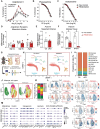This is a preprint.
Ablation of Prdm16 and beige fat causes vascular remodeling and elevated blood pressure
- PMID: 40667352
- PMCID: PMC12262805
- DOI: 10.1101/2025.06.12.658904
Ablation of Prdm16 and beige fat causes vascular remodeling and elevated blood pressure
Abstract
While excess adiposity is a major risk factor for hypertension and cardiovascular disease, brown fat is associated with protection from these pathologies. Whether brown fat has a causal role in this process and the underlying molecular mechanisms remain unknown. Here we investigate the role of murine beige fat, as a model of inducible brown fat in humans, in adipocyte-vascular crosstalk. Using mice with an adipocyte-specific deletion of PRDM16, resulting in a loss of beige adipocyte identity, we discover a dramatic remodeling of perivascular adipose tissue, increased vascular reactivity and elevated blood pressure. We further show that the circulating enzyme Qsox1 is de-repressed in Prdm16-deficient adipocytes, and deletion of Qsox1 in PRDM16cKO mice rescues vascular fibrosis and reactivity. These results demonstrate a key new role for beige adipocytes in blood pressure regulation and identify Qsox1 as an important mediator of adipocyte-vascular crosstalk.
Figures




References
-
- Lawes CMM, Vander Hoorn S, Rodgers A, International Society of Hypertension. Global burden of blood-pressure-related disease, 2001. Lancet. 2008. May 3;371(9623):1513–8. - PubMed
-
- Hypertension Detection and Follow-up Program Cooperative Group. The effect of treatment on mortality in “mild” hypertension: results of the hypertension detection and follow-up program. N Engl J Med. 1982. Oct 14;307(16):976–80. - PubMed
-
- Shulman N, Tuttle E Jr, Entwisle G, Apostolides A, Oberman A, Schnaper HW, et al. Persistence of Reduction in Blood Pressure and Mortality of Participants in the Hypertension Detection and Follow-up Program. JAMA. 1988. Apr 8;259(14):2113–22. - PubMed
-
- Sagie A, Larson MG, Levy D. The natural history of borderline isolated systolic hypertension. N Engl J Med. 1993. Dec 23;329(26):1912–7. - PubMed
Publication types
Grants and funding
LinkOut - more resources
Full Text Sources
Miscellaneous
